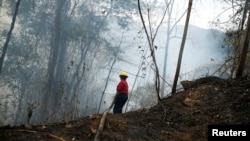The International Labor Organization reports more than 70 percent of workers around the world, over 2.4 billion workers out of a global workforce of 3.4 billion, are exposed to excessive heat and other climate-change-related health hazards.
A new ILO report issued Monday warns existing occupational safety and health protections are struggling to keep up with the resulting risks and is calling on governments to enact policies to shield workers from a “cocktail” of serious health hazards due to climate change.
“Workers often are forgotten when we are talking about climate change and about the health impacts that are very severe from deaths to millions of sick people because of hazards exacerbated by climate change, but also millions living with chronic diseases,” said Manal Azzi, ILO senior specialist on occupational safety and health.
She told journalists in Geneva that numerous dangerous health conditions in workers have been linked to climate change, including cardiovascular disease, respiratory illnesses, kidney disfunction, and mental health conditions “like depression, anxiety, and other issues related to the exposures they are facing.”
The report focuses on several hazards based on their severity and prevalence globally and across regions. The report evaluates the impact on workers from climate-induced hazards such as excessive heat, UV radiation, solar radiation, air pollution and extreme weather events, including flooding, hurricanes, droughts, and wildfires.
“Between 2000 and 2020, there was a 34.7 percent increase in the number of workers exposed to excessive heat,” Azzi said. “This is having detrimental effects on the health of workers, not to mention on the health system as a whole.”
She noted that 22 million workers are suffering from sicknesses and injuries related to exposure to excessive heat and 26 million people are living with chronic diseases caused by lengthy exposure to excessive heat.
“Nearly 20,000 workers are dying yearly because of injuries in the workplace related to rising temperatures and…over two million disability adjusted years are lost because of heat,” she said noting that the reported number of deaths is probably an under-estimation of the true figure.
According to the report, 1.6 billion workers are exposed to UV radiation, with nearly 19,000 work-related yearly deaths from nonmelanoma skin cancer. It says 1.6. billion workers also are exposed to workplace air pollution, resulting in up to 860,000 work-related deaths among outdoor workers annually.
The report finds more than 870 million agricultural workers are “likely to be exposed to pesticides, with more than 300,000 deaths attributed to pesticide poisoning annually.”
New data show that 15,000 people die every year due to exposure to parasitic and vector-borne diseases in the workplace.
“These include a lot of diseases like dengue, rabies, and various diseases that are increasing in regions where we never used to see them before,” said Azzi.
“Malaria is increasing, and it is being seen in countries where it has never been before due to these rising temperatures, humidity, variations in patterns of rainfall and that impacts…the prevalence of these diseases that we are dealing with,” she said.
The ILO says laws and regulations regarding Occupation, Safety, and Health (OSH) must be updated to consider the increasing health hazards linked to climate change. In the meantime, ILO officials say many common-sense measures can and should be taken to protect the welfare and lives of workers.
“Obviously, the key and basic measures—it is not rocket science for the workplace and especially for heat—are hydration and regarding the temperature, limiting the work time and taking very long rest breaks,” said Azzi.
“We have countries that have high degree temperatures that have stopped work between 10:00 am and 3:00 pm on certain workdays. We have measures, for example, to limit pesticides and we know that pesticides have an accumulated effect when they are being sprayed during the hottest moments of the day—where they limit spraying to the cool evening or early morning hours,” she said.
Balint Nafradi, ILO technical officer on OSH says data find areas of greatest concern to be the new regions where heat was never a big issue but have become so because of climate change.
“When it comes to heat, that is in northern Europe and Central Europe. When it comes to heat waves, that is South America, and for UV radiation, that is mostly Australia and Africa,” he said.
Head of ILO’s OSH division, Manal Azzi said, “The key message we want to bring out today is that the hazards are all interlinked, so we cannot be dealing with one of the hazards and forget about the others. We need to be having the right tools to explore and measure what the best solutions are for different places.”
She observed that collective bargaining has been crucial in ensuring the rights of workers in facing, preventing, and protecting them from workplace hazards in the past.
“But we have to now be moving and scaling up globally because the exposure and the impact (of the climate-related hazards) have taken on a whole new scale.”








